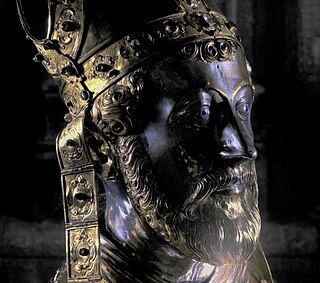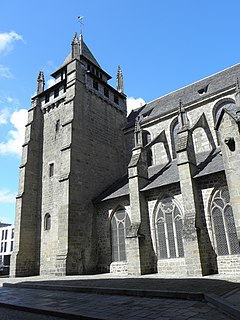Related Research Articles

Saint Martin of Tours was the third bishop of Tours. He has become one of the most familiar and recognizable Christian saints in Western tradition.

In religion, a relic usually consists of the physical remains of a saint or the personal effects of the saint or venerated person preserved for purposes of veneration as a tangible memorial. Relics are an important aspect of some forms of Buddhism, Christianity, Hinduism, Islam, Shamanism, and many other religions. Relic derives from the Latin reliquiae, meaning "remains", and a form of the Latin verb relinquere, to "leave behind, or abandon". A reliquary is a shrine that houses one or more religious relics.

Saint Martial, called "the Apostle of the Gauls" or "the Apostle of Aquitaine", was the first bishop of Limoges. His feast day is June 30.
Gatianus was the founding bishop of the see of Tours. He was one of the "seven apostles of Gaul" commissioned by Pope Fabian to evangelize in the region.

Saint Servatius was bishop of Tongeren —Latin: Atuatuca Tungrorum, the capital of the Tungri—. Servatius is patron saint of the city of Maastricht and the towns of Schijndel and Grimbergen. He is one of the Ice Saints. His feast day is May 13.
Saint Reticius was a bishop of Autun, the first one known to history, according to the Catholic Encyclopedia. He was a Gallo-Roman, and an ecclesiastical writer, and served as bishop of this see from around 310 to 334 AD.

Saint Benignus of Dijon was a martyr honored as the patron saint and first herald of Christianity of Dijon, Burgundy. His feast falls, with All Saints, on November 1; his name stands under this date in the Martyrology of St. Jerome.

The Roman Catholic Diocese of Autun (–Chalon-sur-Saône–Mâcon–Cluny), more simply known as the Diocese of Autun, is a diocese of the Latin Rite of the Roman Catholic Church in France. The diocese comprises the entire Department of Saone et Loire, in the Region of Bourgogne.

Saint Aredius, also known as Yrieix, was Abbot of Limoges and chancellor to Theudebert II, King of Austrasia in the 6th century. He founded the monastery of Attanum, and the various French communes called St. Yrieix are named after him.

Saint-Brieuc Cathedral is a Roman Catholic church located in the town of Saint-Brieuc, Brittany, France, and dedicated to Saint Stephen.

Symphorian, Timotheus (Timothy), and Hippolytus of Rome are three Christian martyrs who though they were unrelated and were killed in different places and at different times, shared a common feast day in the General Roman Calendar from at least the 1568 Tridentine Calendar to the Mysterii Paschalis.
Saint Syagrius was a bishop of Autun. His feast day is August 27.
Gaul was an important early center of Latin Christianity in late antiquity and the Merovingian period. By the middle of the 3rd century, there were several churches organized in Roman Gaul, and soon after the cessation of persecution the bishops of the Latin world assembled at Arles, in AD 314. The Church of Gaul passed through three dogmatic crises in the late Roman period, Arianism, Priscillianism and Pelagianism. Under Merovingian rule, a number of "Frankish synods" were held, marking a particularly Germanic development in the Western Church. A model for the following Frankish synods was set by Clovis I, who organized the First Council of Orléans (511).

Saint Reverianus of Autun was a 3rd-century bishop of Autun.

The Basilica of Saint-Quentin, formerly the Collegiate Church of Saint-Quentin is a Catholic church in the town of Saint-Quentin, Aisne, France. There have been religious buildings on the site since the 4th century AD, which were repeatedly destroyed and rebuilt during the Early Middle Ages. The present basilica was constructed in stages between the 12th and 15th centuries. It was severely damaged in World War I (1914–18), and was only reopened in 1956 after extensive reconstruction.
Saint Nectarius of Autun was a 6th-century bishop of Autun, and a saint of the Roman Catholic Church.
Gregory of Langres, also called Gregory of Autun, was a Gallo-Roman prelate, born around 446, count of Autun, in Saone-et-Loire then once widowed, towards 500, he becomes bishop of Langres, from 506 to his death in 539.
Saint Mederic or Medericus, also known in French as Saint Merri or Médéric, was a monk and a hermit, who is considered patron saint of the right bank of the river Seine in central Paris.
Frodulphe de Barjon, known as St. Frou, born in the seventh century at Autun, and died in the eighth century at Barjon, is a religious and holy French Catholic, disciple of Saint Mederic, patron saint of the right bank.

Saint-Jean-le-Grand abbey of Autun, in Autun, Saône-et-Loire, France, is an abbey of Benedictine nuns, possibly founded by Queen Brunhilda and Bishop Syagrius of Autun. According to Gregory of Tours, it already existed in 589.